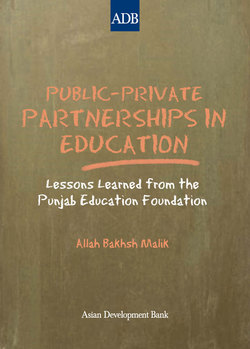Читать книгу Public-Private Partnerships in Education - Allah Bakhsh Malik - Страница 6
FOREWORD
ОглавлениеDeveloping member countries face the twin challenges of increasing access to, and improving the quality of, education. Despite considerable progress in lifting enrollments at the primary education level, a number of countries are at risk of not achieving the universal primary education Millennium Development Goal (MDG) by 2015.
A number of governments have responded to these challenges by making greater use of the private sector and public–private partnerships (PPPs) as a means of improving both the financing and delivery of education. Research by the Asian Development Bank and the World Bank, among others, has documented the wide range of education PPP models in place in both developing and developed countries, including voucher and scholarship programs, the private management of public schools and post-secondary institutions, contracting with private providers for the delivery of educational services, public–private infrastructure partnerships and contracting with the private sector for the delivery of professional or ancillary services.
While PPPs are no panacea, they do offer governments a range of innovative mechanisms for expanding access to education, as well as for improving the quality and efficiency of education at all levels. In an MDG context, PPPs can particularly benefit countries that already have a significant private education sector, as they offer the prospect of rapid scaling up of delivery.
As Public–Private Partnerships in Education: Lessons Learned from the Punjab Education Foundation shows, turning the promise of PPPs into reality on the ground requires a supportive political environment, good program design, and effective implementation. Governments and development partners can draw many lessons from the Punjab Education Foundation’s experience with the introduction of its PPP programs in the education sector.
Norman LaRocque
Senior Education Specialist
Asian Development Bank
